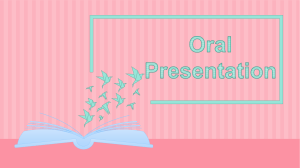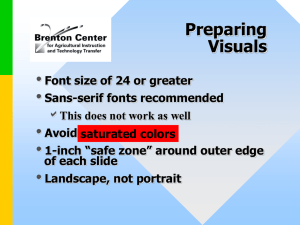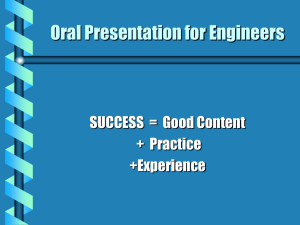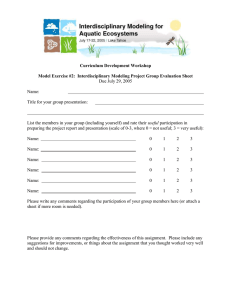English 31 - Oral Presentation - Castañeda, Sarez
advertisement
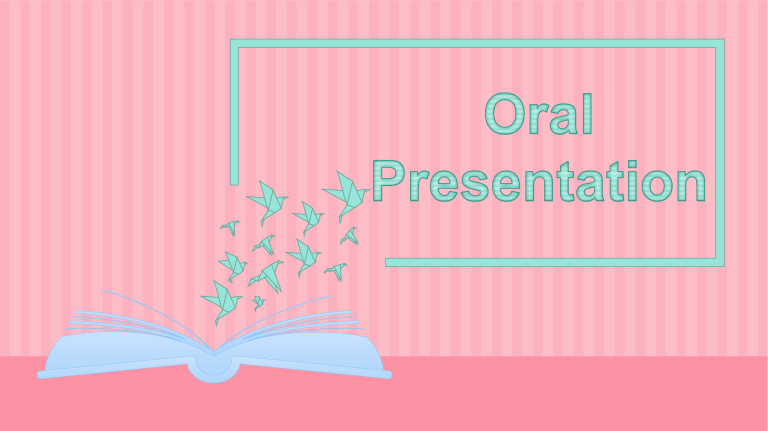
The ability to undertake an oral presentation is a valuable skill for assessment tasks, interviews and your future work life. This skill can be developed by everyone and is not reserved to those who are "naturally" confident at public speaking. This guide will provide you with some tips and techniques for ensuring your presentation is well planned, structured and delivered. Plan Prepare Practice Present A good presentation requires careful planning. This involves analyzing your audience, determining your purpose and strategically selecting appropriate information. Consider the following: • Analyze your audience • Determine the purpose • Select effective information Analyze your audience Consider who it is that you are providing the presentation for and direct your presentation on this basis. Some questions to consider include: • What does your audience know about the subject? • What terminology will they know? • What do they want to know? • How can you engage this audience? What matters to them? Determine the Purpose Be clear about the purpose of your presentation. For instance, is the purpose to provide information, persuade the audience to accept a point of view, or encourage them to take action? Understanding the purpose will inform you as to the information to include for the presentation. Select effective information • If your purpose is to provide your audience with information, you will need to select the most important elements and convey it in a simplified manner. • If you want to persuade your audience to accept a point of view or take action on an issue, then you will need to provide them with reasons and evidence and explain the consequences of their future actions. Select effective information • What kind of information will best support the presentation? • What kind of information will appeal to the audience? • Are there some useful examples or case studies to illustrate an idea? Tip: It is a good technique to prioritize your information and select the three main points for your presentation. This is because your audience's ability to retain information is limited, so select the most important information and focus on presenting it in a clear, concise manner. Things to consider when preparing an oral presentation: • • • • • Structure Preparing the Introduction Preparing the body Prepare the conclusion Select appropriate visual aids Structure Structure provides a framework for your presentation. This will assist you to sort information and remember key ideas, while it will provide your audience with a logical guide as to what will be considered and in what order. A presentation is much like an essay in structure: Introduction - an overview of the issue and the main ideas to be considered. Body - the main ideas, reasoning, evidence and explanation provided. Conclusion - a summary of what you have considered with repetition of key ideas. Preparing the introduction • The purpose of your introduction is to engage your audience, explain the issue and provide an outline of the key points you will be considering. • To engage your audience, you can ask them a question, pose a problem or show them a quick video. • The issue should be explained with the background and key terms explained, while the outline should be a brief summary of the key ideas you will be presented. Preparing the body • The body should contain a clear structure of the main ideas, explanation or reasoning that will be considered. Avoid overloading your audience with too much information but focus on that which is most important. • Categorize your information into key ideas and use numbers and/or phrases that direct your audience. For instance, the first reason, the second reason… Select appropriate visual aids Visual aids can help you convey your point in an engaging and simple manner. These may include PowerPoints, graphs, pictures or objects. • The visual link to your auditory message can be very powerful, but should be used carefully. • Remember that the visuals are not the presentation. Their purpose is to enhance what you are saying by providing a visual link. The key to a good delivery is to practice your speech and your body language. Here are some tips to assist you: Practice • Practice your presentation several times, aloud and standing up. • Time the presentation so that it fits within your allocated time. If it is too long, remove and/or simplify information, rather than speaking more quickly. • Speak naturally from small cue cards, rather than reading from a piece of paper. Know your equipment • Familiarize yourself with the equipment you will use. • Time your presentation using the equipment. • Double-check and make sure that everything works perfectly before the start of the presentation. Delivery • Maintain positive body language, especially with respect to your legs, hands and eyes. • Stand straight with your feet "planted" in the ground. This will eliminate swaying and nervous movements in the legs. You can move, but do so with purpose. Delivery • Establish a "resting place" for your hands at the front of your body, such as cupped at waist level. This will reduce distracting hand movements, such as scratching and fidgeting. • Eye contact is a powerful means to engage your audience so look at your audience when you speak. Be mindful of speaking to everyone at some point, not just the examiner. Delivery • Speak more slowly and clearly than you normally would. Provide emphasis through voice intonation, volume and pausing. • Nervousness is normal. This can be overcome by good preparation, practice, maintaining strong posture and taking deep breaths. MULTIPLE CHOICE 1. A good presentation requires careful _________. This involves analyzing your audience, determining your purpose and strategically selecting appropriate information. a. planning c. speaking b. thinking d. visuals 2. A presentation is much like a(n) __________ in structure. a. novel c. essay b. letter d. story MULTIPLE CHOICE 3. An overview of the issue and the main ideas to be considered. a. Body c. Conclusion b. Introduction d. Recommendation 4. A summary of what you have considered with repetition of key ideas. a. Body c. Conclusion b. Introduction d. Recommendation MULTIPLE CHOICE 5. The main ideas, reasoning, evidence and explanation provided. a. Body c. Conclusion b. Introduction d. Recommendation ENUMERATION Enumerate the following: 1-4 Guidelines to Oral Presentation +1 if you got all otherwise no plus point. Sources: https://www.monash.edu/rlo/quick-study-guides/a-guide-to-oral-presentations (A guide to oral presentations) https://www.youtube.com/watch?v=S5c1susCPAE (Presentation Good/Bad Examples by: Husain Shafei)
